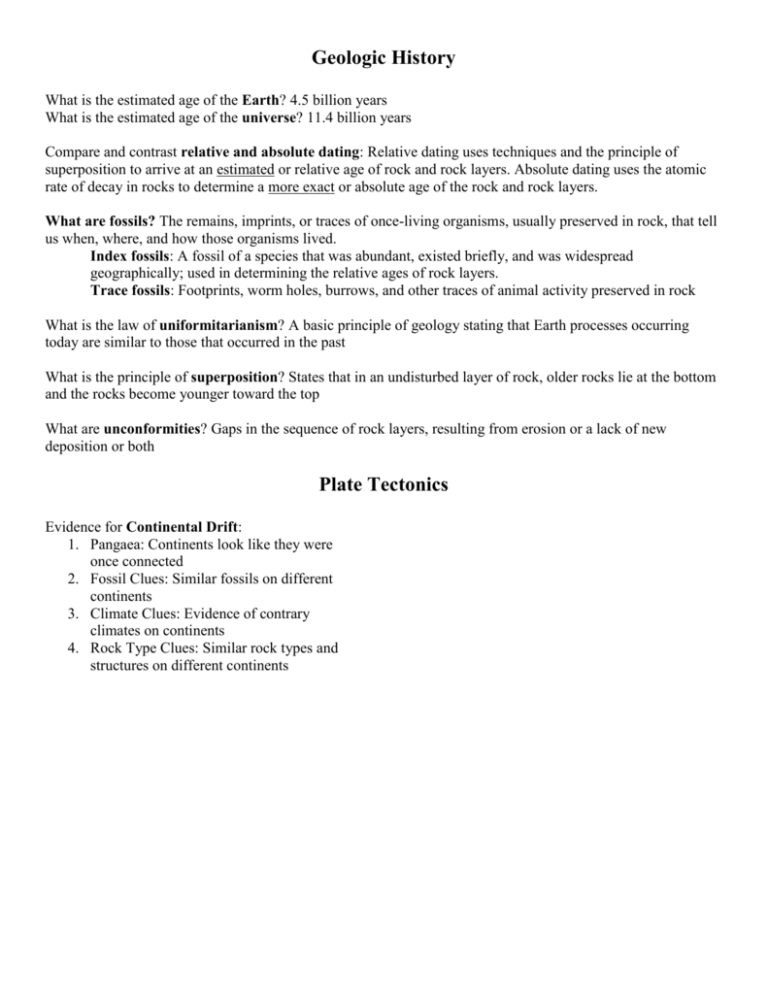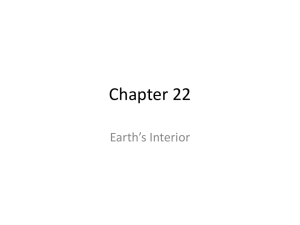Volcanoes - Fair Lawn Schools
advertisement

Geologic History What is the estimated age of the Earth? 4.5 billion years What is the estimated age of the universe? 11.4 billion years Compare and contrast relative and absolute dating: Relative dating uses techniques and the principle of superposition to arrive at an estimated or relative age of rock and rock layers. Absolute dating uses the atomic rate of decay in rocks to determine a more exact or absolute age of the rock and rock layers. What are fossils? The remains, imprints, or traces of once-living organisms, usually preserved in rock, that tell us when, where, and how those organisms lived. Index fossils: A fossil of a species that was abundant, existed briefly, and was widespread geographically; used in determining the relative ages of rock layers. Trace fossils: Footprints, worm holes, burrows, and other traces of animal activity preserved in rock What is the law of uniformitarianism? A basic principle of geology stating that Earth processes occurring today are similar to those that occurred in the past What is the principle of superposition? States that in an undisturbed layer of rock, older rocks lie at the bottom and the rocks become younger toward the top What are unconformities? Gaps in the sequence of rock layers, resulting from erosion or a lack of new deposition or both Plate Tectonics Evidence for Continental Drift: 1. Pangaea: Continents look like they were once connected 2. Fossil Clues: Similar fossils on different continents 3. Climate Clues: Evidence of contrary climates on continents 4. Rock Type Clues: Similar rock types and structures on different continents Evidence for Seafloor Spreading: 1. magnetic clues 2. age evidences 3. the seafloor moves Convection currents: They occur in liquids and solids. Inside the earth, a convection current occurs where in liquid rock or magma. Liquid rock heats due to the hot Earth’s core; it rises to the surface, and begins to cool and sinks down again. This movement is responsible for movement the plates of the Earth. Convection currents also occur in the atmosphere and bodies of water, like the Atlantic Ocean. These convection currents are generated by the heat from the Sun. Plate Boundaries: Convergent: →← move toward each other o Results: Mountains, subduction zone Divergent: ← → move away from each other o Results: valley, seafloor spreading Transform Fault: ↑↓ move alongside each other o Results: earthquakes Continental crust vs. Oceanic crust in plate movement: Since oceanic plates are denser than continental plates, they will go under a continental plate when they move. What is a subduction zone? This is the area where an oceanic plate goes under a continental plate Compare the Lithosphere to the Asthenosphere: The upper mantle and oceanic/continental crust make up the lithosphere. The asthenosphere is the more dense and putty-like, allowing the lithosphere to “float” on the Earth’s surface. Earthquakes What are earthquakes? the movement of the ground, caused by waves from energy released as rocks move along faults What are faults? A break or crack along which rocks move What is the relationship of the earthquake’s focus and the earthquake’s epicenter? The focus is the exact area along the fault where the earthquake occurs. The epicenter is directly above the focus on the surface. The epicenter is where scientists “mark out” the earthquake. 2 Layers of the Earth State of Matter & Physical Characteristics Upper Mantle solid, less dense than the mantle, two types: oceanic crust and continental crust solid, lower part of the lithosphere Lower Mantle Putty-like, more dense than the crust, asthenosphere Crust Outer Core Inner Core LIQUID, melted iron/nickel, works with inner core to create magnetic field around Earth solid iron/nickel, works with outer core to create magnetic field around Earth Seismic Waves: P-waves: Fastest earthquake wave; travels in a pulse like horizontal direction. They travel through liquid and solid. S-waves: Second fastest earthquake wave; travels in a wave-like direction. They travel through solid only. L-waves: Slowest and most destructive. When P and S waves combine they form L-waves. What is a seismograph? How many seismograph stations do seismographers need to do their job? A seismograph is the device that records an earthquake. A seismograph station is the location where the device is. A seismographer is the person who evaluates the data from an earthquake. At least three stations are needed to triangulate the exact location of an earthquake. What is the Richter scale? Scale to determine the seriousness of the earthquake. It’s based on the physical damage caused the quake. Fault Types: Strike Slip Reverse Normal Direction & Movement of fault ↑↓ move alongside each other ← → move away from each other →← move toward each other What does an earthquake have to do with a tsunami? When an earthquake occurs underwater, the large movement of earth may also move a large amount of water above the quake. The large movement of water can turn into a huge wave called a tsunami. Volcanoes What is a volcano? A volcano is simply a hole in the earth where liquid rock reaches the surface. What causes a volcano? Volcanoes are caused by hot spots (super hot areas), seafloor spreading (divergent boundary), and subduction zones (convergent boundary). 3 Volcanoes occur at ... Divergent boundaries Convergent boundaries Hot spots What tectonic action occurs at these places? Example /Areas of this type of volcano ← → move away from each other Mid Atlantic ridge →← move toward each other Area of where the magma is very hot and the earth’s crust may be thin Cascade mountains, Mt. Saint Helens Hawaiian Islands Three types of volcanoes: Shield: gently sloping, dome-shaped volcano composed of quiet lava flows Composite: built up by altering layers of rock particles and lava, largest, surface volcano Cinder Cone: made mostly of cinders and other rock particle that have been blown into the air Explain two important factors that affect the different types of eruptions. A large amount of gases and/or liquids in the magma can make it explosive. The thickness of the magma depends on the amount of silica. More silica equals thicker and more explosive the magma. Minerals What is a mineral? A naturally occurring inorganic solid with a distinct internal crystalline structure and chemical composition Three ways minerals form: 1) evaporation, 2) precipitation, 3) cooling of magma Five characteristics of a mineral: 1. naturally occurring 2. inorganic 3. solid 4. distinct crystalline structure 5. specific chemical composition How many crystal systems are there? 7 Briefly explain the following physical properties of minerals: Color: What the mineral looks like in terms of color. This is the least reliable way to identify a mineral Luster: The shine of mineral. It could be dull or metallic Cleavage: breaking along smooth edges Fracture: breaking along jagged edges Crystal shape: pattern and chemical structure of the mineral 4 Streak: When rubbed, this is the color the mineral leaves on a white or black porcelain tile Hardness: how easily a mineral is scratched What is Mohs’ scale of hardness? Helps evaluate how hard or soft a mineral is. Scale is from 1 to 10. Significant minerals: Largest mineral forming groups: Hardest mineral: diamond Softest mineral: talc silicates 4 general uses of minerals: Answers may vary: medicine (sulfur), nutrition (salt) toothpaste (fluorite), economic exchange (gold and silver), jewelry (diamonds), building material (iron), writing (graphite), and communication and energy (copper) Rocks What is the scientific definition of a rock? Earth material made up of a mixture of one or more minerals, volcanic glass, mineraloids, or organic matter Igneous rocks: Intrusive vs. Extrusive: Both igneous rock form by the cooling of liquid rock. Igneous intrusive rock forms when liquid rock, magma, cools under pressure beneath the surface of the Earth. Igneous extrusive rock forms when liquid rock, lava, cools on the surface of the Earth. Sedimentary: What is the role of compaction and cementation? Compaction squeezes out air and water between the sediments as sedimentary rock forms. Cementation occurs Classification of Sedimentary rock: Sedimentary rock is classified into three categories: detrital, chemical and organic. Detrital rocks contain broken or worn pieces of other rocks. Chemical rocks form when minerals are precipitated or evaporated from a solution. Organic rocks are form from the remains of once living things Metamorphic: What is the role of heat and pressure? Metamorphic rock is formed by heat and pressure. With enough heat and pressure any type of rock can be turned into a metamorphic rock. Metamorphic rock: foliated vs. nonfoliated: These are both types of metamorphic rock. When heat and pressure form layers within the rock, it is called foliated. When layers do not form, it’s called nonfoliated. Draw a picture/diagram of the rock cycle: 5 SOIL AND CLIMATE A horizon- top soil; most rich in nutrients due to animals and plants, decay, waste materials, roots B horizon- sub soil, some nutrients leach down from A horizon. Some roots C horizon- weathered parent rock, very little nutrients, clay Humus- rich organic soil on top layer of A horizon What is below the C horizon? Parent Rock that may or may not be broken up from weathering yet. SPEED OF WEATHERING DEPENDS UPON: a) Climate b) composition of the rock c) exposure to the atmosphere (intense temperatures ) LATITUDE LINES ON THE EARTH AFFECT CLIMATE BECAUSE: They are lined up in relation to the equator, which determines whether the climate is hot and tropical, or cool and dry, etc. Convection currents-:up and down movements of currents of water, air or both in the : a) mantle b) oceans c) atmosphere Astronomy: Sun, Earth, and Moon What is the shape of the Earth? Oblate spheroid What is the difference between rotation and revolution? The Earth rotates on its axis, and revolves or orbits around the Sun. Earth Approx. 365 days Celestial body the object revolves around? Sun Moon 27.3 days Earth Object Revolution: Time Period Rotation: Time Period Approx. 24 hours 27.3 days Why do we only see 1 side of the moon? Because the moon’s rotation is the same as its revolution What is the Earth’s axis and what is the tilt in degrees? Earth’s axis is the invisible point from North to South on which the Earth rotates. It rotates on a 23.5 degree axis. This is also known as Earth’s tilt. 6








